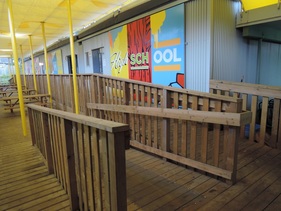
Last week I had the privilege of speaking at the International Dyslexia Association (IDA) Conference in Orlando. My topic was Universal Design for Learning: Implementing a School-wide model for meeting the needs of students with Learning Differences.
As a warm-up for going, I presented a portion of my talk to our teachers and tutors at an after-school staff meeting the week before. They were interested and engaged and recognized how they were implementing the approach in a wide variety of ways in their classrooms and tutoring pods but, in spite of being expert practitioners of UDL on a day to day basis, many of them had never really looked at, or considered, how it framed not only practice, but also informed almost every decision that we made on programmes and services throughout the school. It then occurred to me that if our staff had not thought about universal design in that way, then perhaps the rest of the school community might also need a refresher on why we do what we do at KGMS/Maplewood.
So what is Universal Design? Universal Design has its origins in architecture and technology rather than in education. In a nutshell, it represents innovation that makes a certain building, service, or device accessible to "all" (or at least the vast majority of users). Examples of Universal Design in the everyday world include: automatic doors, which were designed to allow access for wheelchairs, walkers and other supportive devices but also provide the same for parents with strollers, shoppers with arms full of packages, and even giant Superstore shopping carts; ramped entryways, to make certain that every room and area of a building can be accessed but have also created ease of external and internal movement of materials, and heavy equipment; closed captioning, for people with a hearing impairment, which has seen other applications in noisy sports bars and even on the ceiling-installed television screens in the dentist's office; and, needless to say, all contemporary computer/tablet devices which come with variable sized fonts (which means that I can read a book on my iPad in the bright sunshine), volume boosters, tactile and virtual keyboards, and voice-activated functions all of which were designed to make the devices user-friendly for people with physical challenges but also provide off-shoot benefits for all users.
In short, Universal Design, is based on the fundamental assumption that what might be "necessary for one" is "beneficial for all". We are all familiar with the myriad of applications of universal design in our day to day lives, to the point that most of them are almost being taken for granted! But what implications does a universal design approach for a classroom or school? In tomorrow's post we will take a look at how Universal Design for Learning has transformed many of our educational environments and approaches to learning.


 RSS Feed
RSS Feed
